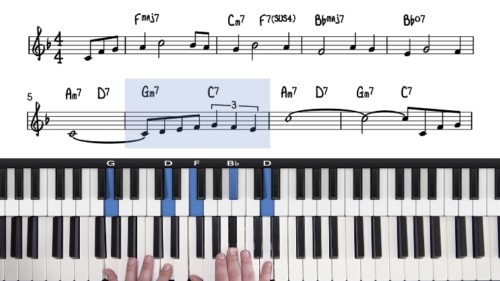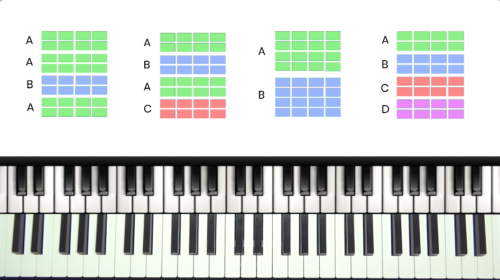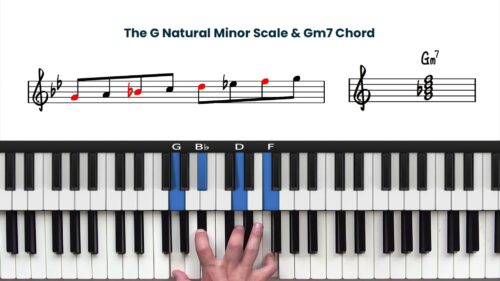How To Play Spread Voicings
In this lesson we arrange the A Section of the tune “Georgia On My Mind” with simple but effective spread voicings. Spread voicings help us to achieve a balanced sound when arranging lead sheets for solo jazz piano performance.
For this module we will stick exclusively to the 1st A Section of “Georgia On My Mind” and in the 2nd module we will learn the B Section of the tune.
Arranging Lead Sheets with Spread Voicings
To arrange a lead sheet for solo piano we must be comfortable with the concept of spread voicings which can also be referred to as shell voicings.
To construct a spread voicing, we play the root note of the chord with our left hand in the lower registers of the piano, we play the melody with our right hand, and we ‘voice’ the 3rd and 7th of the chord in between:

The 3rd and 7th of the chord can be played with either hand, and often this role will be shared between both hands to achieve an even spread of notes on the piano and balanced sound in our voicings.
“Georgia On My Mind” Harmony
After playing through the eight bars, we will examine each bar individually. This step-by-step approach will help you understand the harmony and how to construct suitable spread voicings. Focusing on the root, 3rd, and 7th of each chord provides a solid foundation for creating spread voicings that sound full and balanced.
“Georgia On My Mind” Form & Structure
Learning the form of a tune is crucial for improving the memorisation process. By recognising the recurring patterns and sections, you can more easily internalise the music and recall it during performances.
In “Georgia on My Mind,” the A section serves as a foundation that we will build upon throughout this course.
Lesson Downloads
-
Spread Voicings Notation File Type: pdf
Practice Tips
-
To voice a chord with spread voicings, play the root in the lower register, the melody with your right hand, and then find the 3rd and 7th in between.
-
Outline the quarter note pulse in your left hand to help to you transition to the stride left hand style.
-
Understand that the tunes that we play are always in a fluid state and as we learn new theory and as we develop as musicians we are always enhancing and tweaking our arrangements.
-
Memorise the chords and the melody of the A Section. This might take a few days or a few weeks and once memorised you will be able to play the tune without the lead sheet.








I notice that you change the melody in bar 4 and don’t play the melody note E in bar 5. Is there a reason for that or is it just an improv on the melody?
Hi Michel,
Great question!
Yes exactly as you say… it’s an improv on the melody.
If you listen to 10 different recordings of this tune, you will hear that each musician plays the melody differently. We have the creative freedom to change the notes (to an extent!), add notes in, take notes out, change the phrasing of the notes, add grace notes, chromaticism etc…
The melody should be recognisable but we have the freedom to embellish it as we see fit, and in fact that is exactly what we explore in this course.
Let me know if I can help further and enjoy the lessons!
Best,
Hayden